Advertisements
Advertisements
Questions
A ray of light passing from air through an equilateral glass prism undergoes minimum deviation when the angle of incidence is 3/4 th of the angle of prism. Calculate the speed of light in the prism.
A ray of light incident on face AB of an equilateral glass prism, shows minimum deviation of 30°. Calculate the speed of light through the prism.
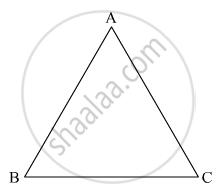
Solution
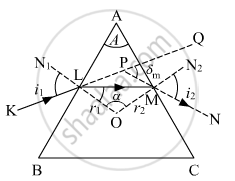
i = 3/4 A for minimum deviation we know,
A + δm = 2i
Therefore, A + δm = 2 × 3/4 A
δm = (1.5 − 1)A
⇒ δm = 0.5 A
For equilateral prism
A = 60° ...(i)
⇒ δm = 0.5 × 60° = 30° ...(ii)
Also, for minimum deviation, refractive index of glass w.r.t. air is given by
`∴μ="speed of light in air (c)"/"speed of light in prism"`...(iii)
`thereforemu=sin((A+δ_m)/2)/sin(A/2)`
`∴μ=sin((60+30)^@/2)/sin(60^@/2)`
`∴μ=sin((90^@)/2)/sin(60^@/2)` ....(iv)
using (iii) and (iv)
`∴"speed of light in prism"="speed of light in air (c)"/μ`
`∴"speed of light in prism" =sin(60^@/2)/sin(90^@/2) xx c`
`= (1/2)/(1/sqrt2)xx 3 × 10^8`
`= 3/sqrt2 × 10^8 "m/s"`
`= 2.12 × 10^8 "m/s"`
APPEARS IN
RELATED QUESTIONS
How does the angle of minimum deviation of a glass prism vary, if the incident violet light is replaced by red light? Give reason.
Three rays (1, 2, 3) of different colours fall normally on one of the sides of an isosceles right angled prism as shown. The refractive index of prism for these rays is 1.39, 1.47 and 1.52 respectively. Find which of these rays get internally reflected and which get only refracted from AC. Trace the paths of rays. Justify your answer with the help of necessary calculations.
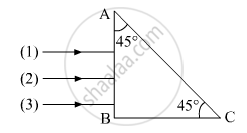
Write the relationship between angle of incidence ‘i’, angle of prism ‘A’ and angle of minimum deviations for a triangular prism.
Trace the path of the ray (P) of light passing through the glass prism as shown in the figure. The prism is made of glass with critical angle ic = 41°.
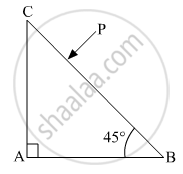
Three light rays red (R), green (G) and blue (B) are incident on a right angled prism ‘abc’ at face ‘ab’. The refractive indices of the material of the prism for red, green and blue wavelengths are 1.39, 1.44 and 1.47 respectively. Out of the three which colour ray will emerge out of face ‘ac’? Justify your answer. Trace the path of these rays after passing through face ‘ab’.
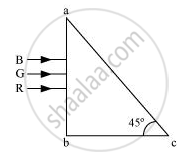
Can you ever have a situation in which a light ray goes undeviated through a prism?
If a piece of paper is placed at the position of a virtual image of a strong light source, will the paper burn after sufficient time? What happens if the image is real? What happens if the image is real but the source is virtual?
An isosceles prism of angle 120° has a refractive index 1.44. Two parallel monochromatic rays enter the prism parallel to each other in air as shown. The rays emerge from the opposite faces:

A horizontal ray of light passes through a prism of index 1.50 and apex angle 4° and then strikes a vertical mirror, as shown in the figure (a). Through what angle must the mirror be rotated if after reflection the ray is to be horizontal?
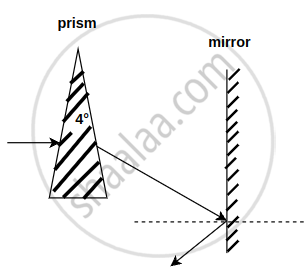
A ray of monochromatic light passes through an equilateral glass prism in such a way that the angle of incidence is equal to the angle of emergence and each of these angles is 3/4 times the angle of the prism. Determine the angle of deviation and the refractive index of the glass prism.
